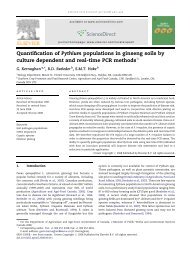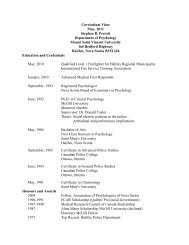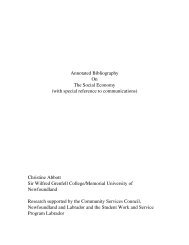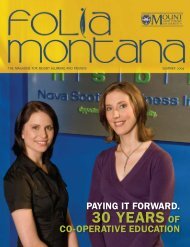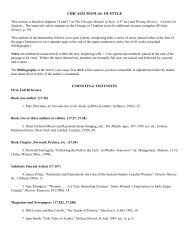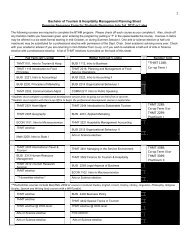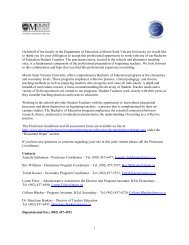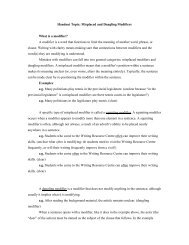Genes, Genomes, and Genomics Evelyn Fox Keller
Genes, Genomes, and Genomics Evelyn Fox Keller
Genes, Genomes, and Genomics Evelyn Fox Keller
- No tags were found...
Create successful ePaper yourself
Turn your PDF publications into a flip-book with our unique Google optimized e-Paper software.
<strong>Genes</strong>, <strong>Genomes</strong>, <strong>and</strong> <strong>Genomics</strong><strong>Evelyn</strong> <strong>Fox</strong> <strong>Keller</strong>Biological TheoryISSN 1555-5542Volume 6Number 2Biol Theory (2012) 6:132-140DOI 10.1007/s13752-012-0014-x1 23
Your article is protected by copyright <strong>and</strong>all rights are held exclusively by KonradLorenz Institute. This e-offprint is for personaluse only <strong>and</strong> shall not be self-archived inelectronic repositories. If you wish to selfarchiveyour work, please use the acceptedauthor’s version for posting to your ownwebsite or your institution’s repository. Youmay further deposit the accepted author’sversion on a funder’s repository at a funder’srequest, provided it is not made publiclyavailable until 12 months after publication.1 23
Author's personal copyBiol Theory (2011) 6:132–140DOI 10.1007/s13752-012-0014-xLONG ARTICLE<strong>Genes</strong>, <strong>Genomes</strong>, <strong>and</strong> <strong>Genomics</strong><strong>Evelyn</strong> <strong>Fox</strong> <strong>Keller</strong>Received: 8 January 2012 / Accepted: 19 January 2012 / Published online: 31 March 2012Ó Konrad Lorenz Institute for Evolution <strong>and</strong> Cognition Research 2012Abstract While scientific terms lack the stability ofphysical objects, they are generally far more stable than thevarious meanings associated with them. As a consequence,they tend to carry older conceptions alongside those morerecently acquired, thereby exerting an effective drag againstconceptual change. I illustrate this claim with an analysis ofthe shifting meanings of the term genome, originally used torefer to a collectivity of genes, but more recently to anorganism’s complement of DNA. While genes were originallyregarded as effectively autonomous formal agents,<strong>and</strong> DNA as collections of genes, contemporary researchsuggests that an organism’s DNA constitutes a far morecomplex system designed to adapt <strong>and</strong> respond to theenvironment in which it finds itself.Keywords DNA <strong>Genes</strong> Genome ncRNA Reactive system RegulationIt has been frequently observed that, unlike DNA, genesare not physical objects but ‘‘merely concepts’’—thingsthat have no fixed existence, <strong>and</strong> about which there can beno single fact of the matter. Indeed, the multiple <strong>and</strong>shifting meanings of this term have been the subject ofextensive discussion by biologists as well as by historians<strong>and</strong> philosophers of biology (see, e.g., Beurton et al. 2000;<strong>Keller</strong> 2000; Snyder <strong>and</strong> Mark Gerstein 2003; Pearson2007). But what is less likely to be noted is that the worditself has demonstrated remarkable endurance since itscoining in 1909. To be sure, it lacks the stability of aphysical object, but my point here is that it has exhibitedfar greater stability than the meanings associated with it.I argue that the endurance of words, especially in the faceof shifting meanings, has important consequences for howwe think about the phenomena these words were intendedto describe. The focus of the present essay is not howeveron the term gene, but rather on the genome, a term introducedonly 11 years after gene.I will use an exploration of the changing meanings ofgenome to illustrate a number of general observationsabout the role of language in scientific thought, <strong>and</strong> morespecifically, about the role of words as vehicles of resistanceto conceptual change. These observations—developedby a variety of authors but perhaps most notably byPolanyi (1958)—can be formulated as follows:(1) Scientific terms (words) often endure for long periods,but because the meanings of these terms dependon the particular context of research, they undergoconstant change. As Michael Polanyi long agoobserved, 1 such changes in meaning occur for themost part outside of ‘‘focal awareness.’’ For thisreason, they tend to evade explicit marking, allowingolder meanings to persist alongside newer meanings,even as a term is used by a single author; indeed, evenin the same text.(2) Polanyi also observed that ‘‘Different languages …sustain alternative conceptual frameworks, interpretingall things that can be talked about in terms of somewhatdifferent allegedly recurrent features’’ (ibid). The pointI wish to stress, however, is that, just as differentE. F. <strong>Keller</strong> (&)Program in Science Technology <strong>and</strong> Society, MassachusettsInstitute of Technology, Cambridge, MA, USAe-mail: efkeller@mit.edu1 He wrote: ‘‘The meaning of speech thus keeps changing in the actof groping for words without our ever being focally aware of thechange, <strong>and</strong> our groping invests words in this manner with a fund ofunspecifiable connotations’’ (1958, p. 112).123
Author's personal copy<strong>Genes</strong>, <strong>Genomes</strong>, <strong>and</strong> <strong>Genomics</strong> 133languages sustain different conceptual frameworks, sotoo do different meanings of the same terms. In effect,different meanings of scientific terms constitute differentscientific languages in <strong>and</strong> of themselves.(3) Through the persistence of older meanings, wordscarry past conceptual frameworks into the present <strong>and</strong>future, sustaining the expectations <strong>and</strong> formulationsthat had originally generated these earlier meanings<strong>and</strong> infusing them into interpretations of new data.In so doing, they constitute vehicles of resistance toconceptual change, imposing an earlier generation’s‘‘particular theory of the nature of things’’ 2 onto acurrent generation’s perspective.What is a Genome?At least four different meanings are commonly invoked indefinitions of the genome, two of them inherited from theera of classical genetics (one referring to genes <strong>and</strong> the otherto chromosomes), the third following the characterization ofDNA as the material basis of inheritance, <strong>and</strong> a fourthwhich at least tacitly opens a question about the relationbetween genes <strong>and</strong> genetic. Of particular interest here willbe the relation between genomes <strong>and</strong> genes. Given its history,it is inevitable that our underst<strong>and</strong>ing of what a genomeis has been (<strong>and</strong> remains) deeply entwined with current<strong>and</strong> prior conceptions of the gene. Furthermore, given thevariability of those conceptions, the relation between thetwo terms will inevitably prove correspondingly unstable.Yet, however variable, I will argue that that relation is itselfof interest; it is also of consequence—not only for how wetalk, but also for how we think. Especially, I suggest that theview—in effect, the default view—of genomes as collectionsof genes (however these are conceived) constrains ourability to conceptually adapt to many of the more radicalfindings of genomic research. Recent work has posed acuteproblems for so simple an underst<strong>and</strong>ing of the relationbetween genes <strong>and</strong> genomes, but of a kind that are oftenmasked by the fluidity of usage of the former term, coupledwith its persistent conjunction with the latter.Usage <strong>and</strong> Meanings of the Term Genome, 1920–1990Like others, Joshua Lederberg <strong>and</strong> Alexa McCray (2001)attribute the coining of the term to Hans Winkler who, in1920, combined the word gene with the part of the wordchromosome (–ome) that signifies the collectivity of unitsto form a new word. The new word, Winkler wrote, refersto ‘‘the haploid chromosome set, which, together with thepertinent protoplasm, specifies the material foundations ofthe species’’ (quoted in Lederberg <strong>and</strong> McCray 2001,p. 8). It was not much used until the early to mid 1960s(see Fig. 1), but when it was employed, it was generallytaken (often without definition) as referring simultaneouslyto an organism’s complement of genes <strong>and</strong> to itsdefining set of chromosomes, the tacit assumption beingthat the two were equivalent—i.e., as if the chromosomesconsisted of nothing (or at least nothing of significance)other than the complement of genes. Thus, e.g., in theirwidely used genetics textbook, Edgar Srb <strong>and</strong> his colleagueswrite: ‘‘Among organisms with chromosomes,each species has a characteristic set of genes, or genome.In diploids a genome is found in each normal gamete.It consists of a full set of the different kinds of chromosomes’’(1965, p. 190). Indeed, it might be argued that thedistinction between a complement of genes (whatever theymight be) <strong>and</strong> a full set of chromosomes was not experimentallyaccessible in the context of classical genetics.It might even be argued that it was correspondinglyinaccessible conceptually; certainly, history suggests thatit was not (or at least not generally) conceptually accessed.In later years, however—<strong>and</strong> especially after theadvent of molecular biology—that distinction did becomeavailable to both conceptual <strong>and</strong> experimental scrutiny.As techniques for distinguishing between DNA <strong>and</strong> thevarious lipids <strong>and</strong> proteins that contribute to the compositionof chromosomes developed, the conceptual differencebetween genes <strong>and</strong> chromosomes inevitably becamemore conspicuous as well. In retrospect, one might thinkthat it would accordingly come to dem<strong>and</strong> explicitmarking. Apparently not so, but I at least want to do so,referring to the complement of genes as genome-1, <strong>and</strong> ofchromosomes, as genome-2.By the 1960s, after DNA had been established as providingthe material basis of genetics, <strong>and</strong> after biologistsbegan to shift their conception of genes from bits ofchromosomes to bits of DNA, the genome also acquired anew (<strong>and</strong> third) meaning: an organism’s complete set ofDNA. Let me call this genome-3. As can be seen fromFig. 1, overall use of the term rises significantly after 1960.Figure 2 shows its usage growing steadily (albeit not yetdramatically) throughout the 1970s <strong>and</strong> 1980s.2 As Polanyi put it, ‘‘In learning to speak, every child accepts aculture constructed on the premises of the traditional interpretation ofthe universe, rooted in the idiom of the group to which it was born,<strong>and</strong> every intellectual effort of the educated mind will be made withinthis frame of reference’’ (ibid).<strong>Genes</strong>, <strong>Genomes</strong> <strong>and</strong> Junk DNAThe interpretation of genomes in terms of DNA comesincreasingly into play during this period, even while earlier123
Author's personal copy134 E. F. <strong>Keller</strong>Fig. 1 Number of articlesreferring to the term genomein the biological literature,1934–1970 (from the Webof Science)Fig. 2 Number of articles referring to genome in the biologicalliterature, 1971–1990 (from the Web of Science)definitions continue to persist. Furthermore, <strong>and</strong> adding yetmore complication, research in molecular biology soon ledto yet another definition, namely the genome as ‘‘all of aliving thing’s genetic material.’’ I call this genome-4.The difference between genes <strong>and</strong> genetic material (information/instructions)—i.e.,between genome-1 <strong>and</strong> genome-4—might not have been meaningful in the days whengenetics referred simply to the science of genes. But from the1970s on, especially as the focus of molecular geneticsshifted to the study of eukaryotic organisms, <strong>and</strong> as the studyof regulation assumed increasing centrality to that science,the relation between genes <strong>and</strong> genetics has come to seemless straightforward. To the extent that regulation is aproperty of DNA, it is surely genetic, but is it alwaysattributable to genes? 3A somewhat different challenge to the equivalencebetween genes <strong>and</strong> genetic material might also have beenprovoked by a series of findings, beginning in the late 1960s,prompting the recognition of substantial expanses of nonprotein-coding(‘‘nongenic’’ or ‘‘extra’’) DNA sequences ineukaryotic genomes. Perhaps most important were the findings(1) of large amounts of repetitive DNA in 1968; (2) of thewildly varying relationship between the amount of DNA in anorganism <strong>and</strong> its complexity (the ‘‘C-value paradox’’; Thomas1971); <strong>and</strong> (3) of split genes (protein-coding sequencesinterrupted by non-coding ‘‘introns’’) in 1977. But the designationof such DNA as ‘‘junk’’—a term first introduced bySusumu Ohno (1972) to refer to the rampant degeneracy (nongenic<strong>and</strong>, as he thought, non-transcribed sequences) ineukaryotic DNA—soon blunted that challenge. After theappearance in 1980 of two back-to-back papers (Doolittle <strong>and</strong>Sapienza 1980; Orgel<strong>and</strong>Crick1980) that linked ‘‘junk’’DNA to Richard Dawkins’ (1976) notion of ‘‘selfish’’ DNA,the idea of ‘‘junk DNA’’ seemed to become entrenched.Orgel <strong>and</strong> Crick begin by writing (1980, p. 604):A piece of selfish DNA, in its purest form, has twodistinct properties:(1) It arises when a DNA sequence spreads by formingadditional copies of itself within the genome.(2) It makes no specific contribution to the phenotype.3 Although not directly germane to the main theme of this essay, itshould be noted that a need to distinguish between genome-3 <strong>and</strong>genome-4 has also been stimulated by current research, especially bythe growing appreciation of alternative forms of inheritance (<strong>and</strong>hence, of alternate meanings of genetic) that arises out of contemporarywork on epigenetics.123
Author's personal copy<strong>Genes</strong>, <strong>Genomes</strong>, <strong>and</strong> <strong>Genomics</strong> 135But the authors want to use the termin a wider sense, so that it can refer not only toobviously repetitive DNA but also to certain otherDNA sequences that appear to have little or nofunction, such as much of the DNA in the introns ofgenes <strong>and</strong> parts of the DNA sequences between genes…. The conviction has been growing that much ofthis extra DNA is ‘‘junk,’’ in other words, that it haslittle specificity <strong>and</strong> conveys little or no selectiveadvantage to the organism … in the case of selfishDNA, the sequence which spreads makes no contributionto the phenotype of the organism, exceptinsofar as it is a slight burden to the cell that containsit. (1980, p. 604)Until the early 1990s, the assumption that the largeamounts of non-coding DNA found in eukaryotic organismshad ‘‘little or no function,’’ contributed nothing totheir phenotype, <strong>and</strong> could therefore be ignored, remainedrelatively uncontested. For all practical purposes, genomes(or at least the interesting parts of genomes) could stillbe thought of as collections of genes. Indeed, when theHuman Genome Project (HGP) first announced its intentionto sequence the entire human genome, much of theopposition to that proposal was premised on this assumption.Thus, e.g., Bernard Davis of the Harvard MedicalSchool complained that ‘‘blind sequencing of the genomecan also lead to the discovery of new genes …, but thiswould not be an efficient process. On average, it would benecessary to plow through 1–2 million ‘junk’ bases beforeencountering an interesting sequence’’ (Davis 1990,p. 343). And in a similar vein, Robert Weinberg of MITargued:The sticky issue arises at the next stage of the project,its second goal, which will involve determiningthe entire DNA sequence of our own genome <strong>and</strong>those of several others. Here one might indeed raisequestions, as it is not obvious how useful most ofthis information will be to anyone. This issue arisesbecause upwards of 95 % of our genome containssequence blocks that seem to carry little if any biologicalinformation. As is well known, our genome isriddled with vast numbers of repetitive sequences,pseudogenes, introns, <strong>and</strong> intergenic segments. TheseDNA segments all evolve rapidly, apparently becausetheir sequence content has little or no effect on phenotype.Some of the sequence information containedin them may be of interest to those studying therecent <strong>and</strong> distant evolutionary precursors of ourmodern genome. But in large part, this vast geneticdesert holds little promise of yielding many gems. Asmore <strong>and</strong> more genes are isolated <strong>and</strong> sequenced, thearguments that this junk DNA will yield great surprisesbecome less <strong>and</strong> less persuasive. (Weinberg1991, p. 78)Weinberg was soon proven wrong. In the mid-1990s,<strong>and</strong> largely as a result of research enabled by large-scaleDNA sequencing, confidence that non-coding DNA is nonfunctional,that it could be regarded as junk, began an evermore rapid decline; <strong>and</strong> by the dawn of the new century,few authors (not even Weinberg) still saw the equationbetween non-coding DNA <strong>and</strong> junk as viable.<strong>Genes</strong>, <strong>Genomes</strong>, <strong>and</strong> <strong>Genomics</strong>, 1990 to the PresentThe launching of the HGP in 1990 was almost certainly themost significant moment in the entire history of the termgenome. From that point on, usage of the term explodes,jumping from 587 references per year in 1989 to 871 in1990, <strong>and</strong> 3,777 in 1991. By 2002, the number passes10,000, <strong>and</strong> by 2010, exceeds 21,000 (see Fig. 3).The numbers displayed in Fig. 3 are telling. In particular,they point to a critical transformation in the history ofgenetics that was in good part triggered by the HGP. Theexplosive growth over these last two decades in use of theterm genome in the professional literature reflects not onlythe rise of a new science of genomics, but also, the growingincompatibilities between its concepts, methods, <strong>and</strong>ontologies <strong>and</strong> those of the earlier science of genetics. AsBarry Barnes <strong>and</strong> John Dupré describe that transition intheir recent book, <strong>Genomes</strong> <strong>and</strong> What to Make of Them, it‘‘involves genomes rather than genes being treated as real,Fig. 3 Number of articles referring to genome in the biologicalliterature, 1989–2010 (from the Web of Science)123
Author's personal copy136 E. F. <strong>Keller</strong><strong>and</strong> systems of interacting molecules rather than sets ofdiscrete particles becoming the assumed underlying objectsof research’’ (2008, p. 8).Yet genes have hardly disappeared from our thinkingabout genomes. To be sure, it has become difficult to find adefinition of the gene upon which researchers can agree,<strong>and</strong> slippage between different underst<strong>and</strong>ings of theterm has become endemic. Nevertheless, gene talk remainsprominent in discussions of genomes, <strong>and</strong> what one meansby the former term inevitably effects how one underst<strong>and</strong>swhat the genome is, <strong>and</strong> about what it does. There doeshowever seem to be a default response that, despite thevariability in definitions of the gene, continues routinely tobe offered whenever a definition is dem<strong>and</strong>ed: the gene is aprotein-coding sequence. And indeed, it is precisely inrelation to this default definition that research in moleculargenomics has proven such a challenge. I briefly referred tothis challenge in my earlier discussion of the rise <strong>and</strong> fall ofthe concept of junk DNA, there suggesting that the demiseof that concept after the mid-1990s can be directly attributedto the growing impact of genomics research. HereI want to elaborate on that suggestion.Of particular importance were the findings, first, thatmuch if not most of the non-coding DNA in eukaryoticorganisms is in fact transcribed; second, that a surprisingrange of regulatory functions (by 2001, these include RNAinterference, co-suppression, transgene silencing, imprinting,<strong>and</strong> methylation) can be attributed to what by this timehad come to be called non-coding RNA (ncRNA); <strong>and</strong>third, that the human genome contains far fewer genes thanhad been anticipated. To some, these findings called for aradical reconceptualization of the nature of genetic regulation,<strong>and</strong> especially, of the role of RNA in the architectureof complexity in higher organisms; others focused onthe unduly restrictive definition of genes as protein codingsequences of DNA, 4 <strong>and</strong> sought to cast ncRNA sequencesas other kinds of ‘‘genes’’ (see, e.g., Eddy 2001). In anycase, all of these developments clearly challenged earlierequations between protein coding sequences <strong>and</strong> function(or more precisely, between non-coding sequences <strong>and</strong>non-function).In 2003, a new public research consortium was launchedby the US National Human Genome Research Institute(NHGRI) with the explicit goal of finding all the functionalelements in the human genome. It was called ENCODE(the ENCyclopedia Of DNA Elements), <strong>and</strong> the results of4 According to John Mattick, e.g., ‘‘The failure to recognize thepossible significance of these RNAs is based on the central dogma, asdetermined from bacterial molecular genetics, that genes are synonymouswith proteins, <strong>and</strong> that RNAs are just temporary reflections ofthis information’’ (2001, p. 987).the first phase—the detailed analysis of 1 % of the humangenome—were reported in The ENCODE Project Consortium(2007). They confirmed that the human genome is‘‘pervasively transcribed’’ (apparently in a developmentallyregulated way); that most of the transcripts are non-coding;that, on the one h<strong>and</strong>, regulatory sequences may overlapprotein coding sequences; on the other h<strong>and</strong>, they are alsooften far removed from coding sequences. Perhaps thebiggest surprise was that functional sequences need not beunder evolutionary constraint.The reaction was swift. In his ‘‘News <strong>and</strong> Views’’commentary on the report, John Greally wrote,We usually think of the functional sequences in thegenome solely in terms of genes, the sequencestranscribed to messenger RNA to generate proteins.This perception is really the result of effective publicityby the genes, who take all of the credit … Theyhave even managed to have the entire DNA sequencereferred to as the ‘genome’, as if the collectiveimportance of genes is all you need to know about theDNA in a cell … Even this preliminary study revealsthat the genome is much more than a mere vehicle forgenes, <strong>and</strong> sheds light on the extensive moleculardecision-making that takes place before a gene isexpressed. (2007, p. 783)Over the last few years, surprises about the range <strong>and</strong>extent of ncRNA involvement in molecular decisionmaking have only accelerated. John Mattick (2010b) putstheir role in the modulation of chromatin architecture <strong>and</strong>epigenetic memory at the top of the list. These are processescrucial not only to embryogenesis but also to braindevelopment, plasticity, learning, <strong>and</strong>, more generally, toregulating the impact of environmental signals. NcRNAtranscripts have been shown to be critical to the regulationnot only of transcription (both cis <strong>and</strong> trans driven), butalso of alternative splicing, of chromosome dynamics, <strong>and</strong>of epigenetic memory. Finally, <strong>and</strong> perhaps most revolutionary,are the findings that implicate ncRNA in theediting of RNA transcripts, thereby modulating the configurationof the regulatory networks these transcripts form.Behavioral (or physiological) adaptation does notrequire that environments can directly alter DNA sequence:environmental signals trigger a wide range of signaltransduction cascades that lead to short-term adaptation.But mechanisms for editing RNA sequences that in turnregulate gene expression may provide the most dramaticcase yet for environmental adaptation. Moreover, epigeneticmechanisms (also mediated by ncRNA) begin todissolve the distinction between short-term <strong>and</strong> long-termadaptations by lending to such adaptations the possibilityof being transmitted inter-generationally. As Mattickexplains, ‘‘the ability to edit RNA … suggests that not only123
Author's personal copy<strong>Genes</strong>, <strong>Genomes</strong>, <strong>and</strong> <strong>Genomics</strong> 137proteins but also—<strong>and</strong> perhaps more importantly—regulatorysequences can be modulated in response to externalsignals <strong>and</strong> that this information may feedback via RNAdirectedchromatin modifications into epigenetic memory’’(2010a, p. 551).Finally, environmental signals are not restricted to thesimple physical <strong>and</strong> chemical stimuli that directly impingeon the skin: organisms with central nervous systems havereceptors for forms of perception that are both far morecomplex <strong>and</strong> longer range. Humans have especiallysophisticated perceptual capacities, enabling them torespond to a wide range of complex visual, auditory, linguistic,<strong>and</strong> behavioral/emotional signals in their extendedenvironment. Apparently, as researchers have recentlybegun to demonstrate, responses to such signals can extendall the way down to the level of gene expression. Forinstance, in 2007 Steve Cole <strong>and</strong> his colleagues comparedthe gene expression patterns in the leukocytes of those whofelt socially isolated with the expression patterns of thosewho felt connected to others, <strong>and</strong> were able to demonstratesystematic difference in the expression of roughly 1 % ofthe genes assayed (Cole et al. 2007). Subsequent studieshave correlated gene expression patterns with other socialindicators (e.g., socioeconomic status), providing furtherevidence for mechanisms of ‘‘social signal transduction’’that reach all the way down to the level of the genome.Cole explains that, ‘‘Socio-environmental processes regulatehuman gene expression by activating central nervoussystem processes that subsequently influence hormone <strong>and</strong>neurotransmitter activity in the periphery of the body.Peripheral signaling molecules interact with cellularreceptors to activate transcription factors’’ (2009, p. 133).What is a Genome Today?As experts in the field now generally recognize, the gapbetween a full complement of protein-coding sequences<strong>and</strong> the genetic material (or DNA) of an organism is in facthuge: e.g., only 1.2 % of human DNA is currently estimatedto be devoted to protein-coding sequences. Yet evenin the face of so glaring a disparity, even with the growingrecognition of how complex <strong>and</strong> multi-layered are theregulatory processes enabled by the genome, that entitycontinues to be understood as a collection of genes that arethemselves impervious to environmental input. To be sure,other definitions of the genome have been added since theterm was first introduced (genome-3 <strong>and</strong> genome-4), butneither of these has quite replaced the original definition(genome-1). Instead, the more recent definitions appear tohave simply adjoined to the others, as if the genome canstill be understood as indiscriminately referring to theorganism’s totality of genes <strong>and</strong> its totality of DNA, <strong>and</strong> asif the meaning of genetic material (information orinstructions) could still be reduced to a set of discrete <strong>and</strong>autonomous units called genes. Indeed, a review of themajor current scientific glossaries suggests that all fourmeanings of the term continue in common usage to thepresent day, in a pattern of coexistence that can be readilyobserved from the list of definitions shown in Table 1.(It should be noted that the glossaries cited are intended forthe larger professional <strong>and</strong> non-professional community;they are organized in an effort to educate <strong>and</strong> inform nontechnicalreaders of the meanings of these terms asemployed in the technical literature.)Thus, for example, the Oxford Dictionary of Geneticshappily defines the genome as ‘‘the total DNA’’ in achromosome set [genome-3] or ‘‘all of the genes carried by… this chromosome set’’; the Craig Venter Institute definesit, alternately, as ‘‘all of a living thing’s genetic material,’’‘‘the entire set of hereditary instructions for building,running, <strong>and</strong> maintaining an organism, <strong>and</strong> passing life onto the next generation’’ (genome-4), ‘‘A collection ofgenes’’ (genome-1), <strong>and</strong> ‘‘all the DNA in a cell’’ (genome-3). The Science Primer provided by the NIH similarlyconfounds these various definitions, telling us that agenomecontains all of the biological information needed tobuild <strong>and</strong> maintain a living example of that organism[genome-4]. The biological information contained ina genome is encoded in its deoxyribonucleic acid(DNA) [genome-3] <strong>and</strong> is divided into discrete unitscalled genes [genome-1]. <strong>Genes</strong> code for proteins thatattach to the genome at the appropriate positions <strong>and</strong>switch on a series of reactions called gene expression.Old <strong>and</strong> New Conceptual FrameworksWhat is most immediately striking here is not only thepersistence of older usages of the term, maintainedalongside meanings corresponding to more recent experimentalpractices, but also, through that persistence, theperpetuation of conceptual frameworks to which the oldermeanings were attached. Thus, e.g., an underst<strong>and</strong>ing ofthe genome as an organism’s totality of genes recalls theclassical discourse of gene action <strong>and</strong> Alfred H. Sturtevant’sreformulation of embryology’s question of how anegg develops into a complex many-celled organism as oneof ‘‘how genes produce their effects.’’ As Sturtevant wrote,‘‘in most cases there is a chain of reaction between thedirect activity of a gene <strong>and</strong> the end-product that thegeneticist deals with as a character’’ (1932, p. 307).Molecular biology succeeded in unpacking that ‘‘chain ofreaction’’: genes were identified as DNA sequences, their123
Author's personal copy138 E. F. <strong>Keller</strong>Table 1 Definitions of genome obtained from a range of scientific glossaries (both official <strong>and</strong> semi-official)SourceBiology Online, http://www.biology-online.org/dictionaryOxford Reference Dictionary of BiologyOxford Reference Dictionary of GeneticsGlossary of Genetic Terms, Genetic Education Center,Univ. of Kansas Medical CenterGlossary, Human Genome Project Information,(http://www.oml.gov/sci/techresources/Human_Genome/glossary)National Human Genome Research Institute Glossary(http://ghr.nlm.nih.gov/glossary=genome)National Human Genome Research Institute, GeneticHome Reference H<strong>and</strong>book(http://ghr.nlm.nih.gov/h<strong>and</strong>book/hgp/genome)Genome News Network, Craig Venter Institutehttp://www.genomenewsnetwork.org/resources/whats_a_genome/Chp1_1_1.shtmlGenome News Network, Craig Venter Institute, Glossaryhttp://www.genomenewsnetwork.org/resources/glossary/index.php#gNational Center for Biotechnology Information, SciencePrimer, NIH http://www.ncbi.nlm.nih.gov/About/primer/genetics_genome.htmlDefinitions(1) The complete set of genes in an organism(2) The total genetic content in one set of chromosomesAll the genes contained in a single set of chromosomes, i.e. in a haploid nucleusIn prokaryotes <strong>and</strong> eukaryotes, the total DNA in a single chromosome <strong>and</strong> in ahaploid chromosome set (q.v.), respectively. or all of the genes carried by thischromosome or chromosome set; in viruses, a single complement of DNA orRNAAll of the genes carried by a single gamete; the DNA content of an individual,which includes 44 autosomes, 2 sex chromosomes, <strong>and</strong> the mitochondrial DNAAll genetic material in the chromosomes of a particular organism; its size isgenerally given as its total number of base pairsThe genome is the entire set of genetic instructions found in a cell. In humans,the genome consists of 23 pairs of chromosomes, found in the nucleus, as wellas a small chromosomes found in the cells’ mitochondria. These chromosomes,taken together, contain approximately 3.1 billion bases of DNA sequenceA genome is an organism’s complete set of DNA, including all of its genes. Eachgenome contains all of the information needed to build <strong>and</strong> maintain thatorganismA gene is a small piece of the genome. It’s the genetic equivalent of the atom: asan atom is the fundamental unit of matter, a gene is the fundamental unit ofheredity…A genome is all of a living thing’s genetic material. it is the entire set ofhereditary instructions for building, running, <strong>and</strong> maintaining an organism, <strong>and</strong>passing life on to the next generation. The whole shebangGene A piece of DNA used by cells to manufacture proteins, which carry out thebusiness of cells. Each human gene is a template for one or more proteinsGenome A collection of genes. All living things have genomes…A genomecontains contains the biological information for building, running, <strong>and</strong>maintaining an organism—<strong>and</strong> for passing life on to the next generation…Aprecise definition of genome is ‘‘all the DNA in a cell’’ because this includesnot only genes but also DNA that is not part of a gene, or non-coding DNALife is specified by genomes. Every organism, including humans, has a genomethat contains all of the biological information needed to build <strong>and</strong> maintain aliving example of that organism. The biological information contained in agenome is encoded in its deoxyribonucleic add (DNA) <strong>and</strong> is divided intodiscrete units called genes. <strong>Genes</strong> code for proteins that attach to the genome atthe appropriate positions <strong>and</strong> switch on a series of reactions called geneexpression‘‘direct activity’’ as that of coding for proteins, <strong>and</strong> the‘‘discourse of gene action’’ was replaced by the centraldogma. Indeed, the Craig Venter Institute’s genome (likethat implied by the Science Primer of the NIH) is still a‘‘collection of genes’’ carrying ‘‘the entire set of hereditaryinstructions for building, running, <strong>and</strong> maintaining anorganism, <strong>and</strong> passing life on to the next generation.’’Despite all the changes our conception of gene hasundergone since the days of Sturtevant, even the mostrecent formulations retain the view of genes (<strong>and</strong> hence ofgenomes) as effectively autonomous formal agents, containing‘‘all of the biological information needed to build<strong>and</strong> maintain a living example of that organism,’’ theblueprint for an organism’s life. But current research ingenomics leads to a rather different picture, <strong>and</strong> it does soby focusing attention on features that have so far beenmissing from our conceptual framework. In addition toproviding information required for building <strong>and</strong> maintainingan organism, the genome also provides a vast amountof information for adapting <strong>and</strong> responding to—for interactingwith—the environment in which it finds itself—asindeed it must if the organism is to develop more or lessnormally, <strong>and</strong> to survive more or less adequately.Rather than a set of genes initiating causal chainsleading to the formation of traits, I suggest that the genomethat now appears before us is first <strong>and</strong> foremost anexquisitely sensitive reaction (or response) mechanism—adevice for regulating the production of specific proteins in123
Author's personal copy<strong>Genes</strong>, <strong>Genomes</strong>, <strong>and</strong> <strong>Genomics</strong> 139response to the constantly changing signals it receives fromits environment. The signals that the genome detects comemost immediately from its intra-cellular environment, butthese reflect, in turn, input from the external environmentsboth of the cell <strong>and</strong> of the organism.This reformulation gives rise to an obvious question:if the genome is so responsive to its environment, how is itthat the developmental process is as reliable as it is? This isa question of major importance in biology, <strong>and</strong> it is rapidlybecoming evident that the answer must be sought not onlyin the structural (sequence) stability of the genome, butalso in the relative constancy of the environmental inputs,<strong>and</strong>, most importantly, in the dynamic stability of thesystem as a whole (see, e.g., <strong>Keller</strong> 2000). <strong>Genomes</strong> areresponsive, but far from infinitely so; the range of possibleresponses is severely constrained, both by the organizationaldynamics of the system in which they are embedded<strong>and</strong> by their own structure.Conclusion: Consequences of Such a ReformulationChanges in DNA sequences (mutations) deserve the attentionwe give them because they endure, passed on from onegeneration to the next—in a word, inherited. Even if notthemselves genes, they are clearly genetic. Some of thesemutations may affect protein sequences, but far morecommonly, what they alter is the organism’s capacity torespond effectively to the environment in which the DNAfinds itself, or to respond differentially to altered environments.This conclusion may be especially important inmedical genomics where researchers routinely seek tocorrelate the occurrence of disease with sequence variationsin the DNA. Since the sequences thus identified are rarelylocated within protein-coding regions of the DNA, thesignificance of the correlation must lie elsewhere, i.e., in theregulatory functions of the associated non-genic DNA.Mutations also provide the raw material for naturalselection. But when we speak of natural selection as havingprogrammed the human genome, we should remember thatit is precisely the capacities to respond <strong>and</strong> adapt for whichnatural selection has programmed the human genome.Unfortunately however, the easy slide from genetics to talkabout genes, with all the causal attributes conventionallyattributed to those entities, makes this an exceedingly hardlesson to keep hold of.Finally, this reconceptualization of the genome allowsus—indeed obliges us—to ab<strong>and</strong>on the twin dichotomies—on the one h<strong>and</strong>, between genetics <strong>and</strong> environment, <strong>and</strong> onthe other, between nature <strong>and</strong> culture—that have driven somuch unnecessary debate, for so many decades. If much ofwhat the genome ‘‘does’’ is to respond to signals fromits environment, then the bifurcation of developmentalinfluences into the categories of genetic <strong>and</strong> environmentalmakes no sense. Similarly, if we underst<strong>and</strong> the termenvironment to include cultural dynamics (as indeed wemust), neither does the bifurcation of biological <strong>and</strong>cultural factors. We have long understood that organismsinteract with their environments, that interactions betweengenetics <strong>and</strong> environment, between biology <strong>and</strong> culture, arecrucial to making us what we are. What research ingenomics has shown is that biology itself is constituted bythose interactions, <strong>and</strong> is so constituted at every level, evenat the level of genetics. Indeed, one might say that whatmakes a molecule—any molecule—biological is preciselyits capacity to sense <strong>and</strong> react to its environment. To quotea recent article on ‘‘Biology as Reactivity’’—i.e., on thevalue of viewing biological systems as fundamentallyreactive systems— ‘‘reactive systems ‘live’ … in order toreact’’ (Fisher et al. 2011, p. 73).That scientific terms point us to the future even whilecarrying baggage from the past seems clear. The fact thatthis dual role can give rise to tension seems equally clear.There is, after all, an inherent unpredictability to scientificinquiry. As Hans-Jorg Rheinberger (1997) has stressed,experimental systems are mechanisms for generatingsurprise <strong>and</strong> novelty. Sometimes, the surprises generatedby new research dem<strong>and</strong> a turn from past conceptualizationsso sharp that the older terms can no longer bear thetension. The obvious question is: does molecular biologynow find itself at such a crossroads?ReferencesBarnes B, Dupré J (2008) <strong>Genomes</strong> <strong>and</strong> what to make of them.University of Chicago Press, ChicagoBeurton PJ, Falk R, Rheinberger HJ (eds) (2000) The concept of thegene in development <strong>and</strong> evolution. Cambridge University Press,CambridgeCole SW (2009) Social regulation of human gene expression. CurrDir Psychol Sci 18(3):132–137Cole SW, Hawkley LC, Arevalo JM, Sung CY, Rose RM, CacioppoJT (2007) Social regulation of gene expression in humanleukocytes. Genome Biol 8:R189Davis BD (1990) The human genome <strong>and</strong> other initiatives. Science249(4967):342–343Dawkins R (1976) The selfish gene. Oxford University Press,New YorkDoolittle WF, Sapienza C (1980) Selfish genes, the phenotypeparadigm <strong>and</strong> genome evolution. Nature 284(5757):601–603Eddy SR (2001) Non-coding RNA genes <strong>and</strong> the modern RNA world.Nat Rev Genet 2:919–929Fisher J, Harel D, Henzinger TA (2011) Biology as reactivity.Commun ACM 54(10):72–82Greally JM (2007) <strong>Genomics</strong>: encyclopaedia of humble DNA. Nature447:782–783<strong>Keller</strong> EF (2000) The century of the gene. Harvard University Press,CambridgeLederberg J, McCray AT (2001) ‘Ome sweet’ omics: a genealogicaltreasury of words. Scientist 15(7):8123
Author's personal copy140 E. F. <strong>Keller</strong>Mattick JS (2001) Non-coding RNAs: the architects of eukaryoticcomplexity. EMBO Rep 2(11):986–991Mattick JS (2010a) RNA as the substrate for epigenome–environmentinteractions. BioEssays 32:548–552Mattick JS (2010b) Non-coding RNAs in epigenetics (interview).http://www.epigenie.com/Interviews/John-Mattick-ncRNAs-onthe-Epigenome.html.Accessed 15 Dec 2011Ohno S (1972) So much ‘‘junk’’ DNA in the genome. In: Smith HH(ed) Evolution of genetic systems. Brookhaven symposia inbiology, vol 23. Gordon & Breach, New York, pp 366–370Orgel LE, Crick FH (1980) Selfish DNA: the ultimate parasite. Nature284(5757):604–607Pearson H (2007) Genetics: what is a gene? Nature 441:398–401Polanyi M (1958) Personal knowledge: towards a post-criticalphilosophy. University of Chicago Press, ChicagoRheinberger HJ (1997) Toward a history of epistemic things:synthesizing proteins in the test tube. Stanford University Press,StanfordSnyder M, Mark Gerstein M (2003) Defining genes in the genomicsera. Science 300(5617):258–260Srb AM, Owen RD, Edgar RS (1965) General genetics, 2nd edn.Freeman & Company, New YorkSturtevant AH (1932) The use of mosaics in the study of thedevelopmental effects of genes. In: Proceedings of the sixthinternational congress of genetics, Ithaca, New York, p 304The ENCODE Project Consortium (2007) Identification <strong>and</strong> analysisof functional elements in 1% of the human genome by theENCODE pilot project. Nature 447:799–816Thomas CA Jr (1971) The genetic organization of chromosomes.Annu Rev Genet 5:237–256Weinberg RA (1991) There are two large questions. Debate 5:78123



